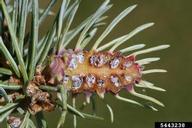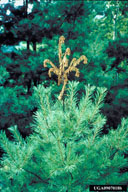Keep your weather eye open: using sentinel plants and weather info to stay abreast of pests
Growers statewide are gearing up for the growing season: calibrating their equipment, prepping fields, packing their greenhouse benches, seeding the earliest crops. And though the main crop of insect pests needs a spell of warm weather to rev up, those in the tree business know they’d best be scouting already — because some of their trickiest pests are already out of the gate.
Examples? Consider white pine weevils, Cooley spruce gall agelgid, and pales (pay-leez)weevils. All three can hammer Christmas tree growers, while landscapers, arborists, and

nursery growers should acquaint themselves with the first two — and learn which plants in the landscape can alert them that it’s time to look sharp. Pussy willow, star magnolia, silver maple — think of them as sentinel plants. Because when they bloom, they remind growers and landscapers that it’s time to review their identification guides, dust off their 10-power hand lenses, and look for this trio’s adults and feeding signs.
But growers — all growers, and even hard-core gardeners — can also use growing degree days, or GGDs. That’s because insects are totally temperature-dependent. They’re unable to grow, let alone function, if temperatures are too cold (or hot!). For some, the thermometer needs to read 50°F — called “base 50” in the trade — before they can get revved. For others, it’s base 48, 45, 43, 40 — even base 32 for the hardiest.
Keeping a running tally of how many hours of each day are in any one pest’s good-to-go range tells growers when it’s time to scout and what their window of opportunity is. After all, waiting

till a pest has reached adulthood if it does damage as a nymph or larva can be a recipe for disaster, or at least a very bad year. Especially if growers are unlikely to notice damage until it’s too late, as is often the case with tiny weevils and mites.
In the old days, growers used to calculate GDDs themselves. Now getting GDDs is easy. And all they have to do is fire up their computers, go to the NEWA (Network for Environment and Weather Applications) website, and click on the NEWA weather station closest to them from the scores of stations in New York and across the Northeast. These stations keep a running tally of GDDs day in and out. NEWA also publishes pest forecasts for a wide range of field, vegetable, and fruit crops — though nursery and Christmas tree growers must take one more step by clicking here to find the GDDs relevant to their pests; here to find more on coping with pests. Or order a hard copy of Cornell’s Tree and Shrub guidelines.